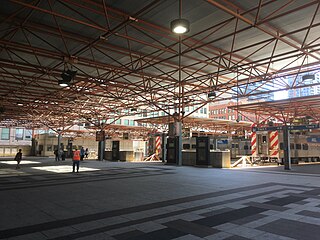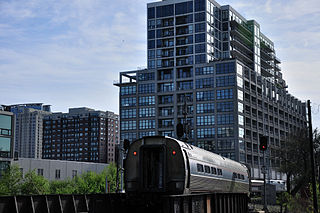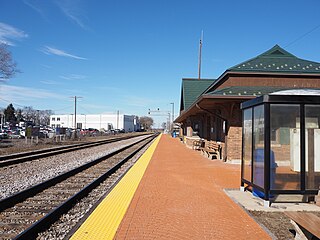
The Chicago, Milwaukee, St. Paul and Pacific Railroad (ACMStP&P), better known as the Milwaukee Road, was a Class I railroad that operated in the Midwest and Northwest of the United States from 1847 until 1986.

Chicago Union Station is an intercity and commuter rail terminal located in the West Loop neighborhood of the Near West Side of Chicago. Amtrak's flagship station in the Midwest, Union Station is the terminus of eight national long-distance routes and eight regional corridor routes. Six Metra commuter lines also terminate here.

The Chicago and North Western was a Class I railroad in the Midwestern United States. It was also known as the "North Western". The railroad operated more than 5,000 miles (8,000 km) of track at the turn of the 20th century, and over 12,000 miles (19,000 km) of track in seven states before retrenchment in the late 1970s. Until 1972, when the employees purchased the company, it was named the Chicago and North Western Railway.

The Lincoln Service is a 284-mile (457 km) higher-speed rail service operated by Amtrak that runs between Chicago, Illinois and St. Louis, Missouri. The train is a part of the Illinois Service and is partially funded by the Illinois Department of Transportation. The train uses the same route as the long-distance Texas Eagle, which continues to San Antonio and Los Angeles. A connection with the Kansas City-bound Missouri River Runner is available in St. Louis.

The Milwaukee District North Line (MD-N) is a Metra commuter rail line in Chicago, Illinois and its northern suburbs, running from Union Station to Fox Lake. Although Metra does not refer to any of its lines by color, the timetable accents for the Milwaukee District North line are pale "Hiawatha Orange" in honor of the Milwaukee Road's Hiawatha passenger trains.

The SouthWest Service (SWS) is a Metra commuter rail line, running southwest from Union Station in downtown Chicago, Illinois, to Manhattan, Illinois. Metra does not refer to its lines by color, but the timetable accents for the SouthWest Service line are "Banner Blue," for the Wabash Railroad's Banner Blue passenger train. The trackage is owned by Metra north of a junction with the Belt Railway of Chicago at Loomis Boulevard, and is leased from Norfolk Southern Railway south of the junction.

Central Station was an intercity passenger terminal in downtown Chicago, Illinois, at the southern end of Grant Park near Roosevelt Road and Michigan Avenue. Owned by the Illinois Central Railroad, it also served other companies via trackage rights. It opened in 1893, replacing Great Central Station, and closed in 1972 when Amtrak rerouted services to Union Station. The station building was demolished in 1974. It is now the site of a redevelopment called Central Station, Chicago.

LaSalle Street Station is a commuter rail terminal at 414 South LaSalle Street in downtown Chicago. First used as a rail terminal in 1852, it was a major intercity rail terminal for the New York Central Railroad until 1968, and for the Chicago, Rock Island and Pacific Railroad until 1978, but now serves only Metra's Rock Island District. The present structure became the fifth station on the site when its predecessor was demolished in 1981 and replaced by the new station and the One Financial Place tower for the Chicago Stock Exchange. The Chicago Board of Trade Building, Willis Tower, and Harold Washington Library are nearby.

The St. Charles Air Line is a rail line in Chicago, Illinois, partially owned by the BNSF Railway, Union Pacific Railroad (UP), and Canadian National Railway (CN).

Englewood Union Station was a major rail junction and passenger depot in the Englewood neighborhood of Chicago, Illinois. Four railroads served the station in its prime – the Chicago, Rock Island and Pacific Railroad, the New York Central Railroad, the Pennsylvania Railroad, and New York, Chicago and St. Louis Railroad, which operated over the New York Central via trackage rights. The station closed in 1978 when the Rock Island closed intercity rail operations and intermediate stops between LaSalle Street and Gresham. There are presently no plans to reopen the station.
The Pittsburgh, Fort Wayne and Chicago Railway was a major part of the Pennsylvania Railroad system, extending the PRR west from Pittsburgh, Pennsylvania, via Fort Wayne, Indiana, to Chicago, Illinois. It included the current Norfolk Southern-owned Fort Wayne Line east of Crestline, Ohio, to Pittsburgh, and the Fort Wayne Secondary, owned by CSX, from Crestline west to Tolleston in Gary, Indiana. CSX leased its entire portion in 2004 to the Chicago, Fort Wayne and Eastern Railroad (CFE). The remaining portion of the line from Tolleston into Chicago is now part of the Norfolk Southern's Chicago District, with a small portion of the original PFW&C trackage abandoned in favor of the parallel lines of former competitors which are now part of the modern NS system.

The Chicago and Western Indiana Railroad was the owner of Dearborn Station in Chicago and the trackage leading to it. It was owned equally by five of the railroads using it to reach the terminal, and kept those companies from needing their own lines into the city. With the closure of Dearborn Station in 1971 and the Calumet steel mills in 1985, the railroad was gradually downgraded until 1994 when it became a subsidiary of the Union Pacific Corporation.

The Alton Railroad was the final name of a railroad linking Chicago to Alton, Illinois; St. Louis, Missouri; and Kansas City, Missouri. Its predecessor, the Chicago and Alton Railroad, was purchased by the Baltimore and Ohio Railroad in 1931 and was controlled until 1942 when the Alton was released to the courts. On May 31, 1947, the Alton Railroad was merged into the Gulf, Mobile and Ohio Railroad. Jacob Bunn had been one of the founding reorganizers of the Chicago & Alton Railroad Company during the 1860s.

The Brighton Park crossing is a major railroad crossing in Chicago, Illinois, hosting three major freight railroads. The crossing is northwest of the intersection of Western Avenue and Archer Avenue, in the Brighton Park neighborhood of Chicago, Illinois. The railroads involved in the crossing are CSX, Canadian National and Norfolk Southern. The crossing consists of the CN's two-track Joliet Subdivision in a roughly east–west orientation intersecting five north–south tracks operated by NS and CSX. Collectively, these railroads operate approximately 80 trains per day through the crossing. The junction is visible from the CTA Orange Line trains that pass on an elevated structure immediately southeast of the crossing.

Rondout is an unincorporated community in Lake County, Illinois, United States that first formed around a railroad junction. The area is located within Libertyville Township. As Rondout is an unincorporated community rather than a municipality, it lacks clearly defined borders, and shares postal codes with Lake Bluff, Lake Forest and Libertyville, Illinois. It has its own elementary school which comes under Rondout School District 72. Illinois Route 176 passes east–west through Rondout, serving as the "main street" of the community, where it is also called "Rockland Road".
The Alton Junction, more commonly known as the 21st Street Crossing, is a historically significant rail location in Chicago, Illinois. The junction can be found just east of Canal Street and north of Cermak Road near Chicago's Chinatown. It is located just south of a massive vertical lift bridge that spans the South Branch of the Chicago River and "guards" the entrance to Chicago's Union Station. While a significant amount of rail traffic still traverses this interlock every day, it has been greatly reduced from using 26 diamonds to control over 150 trains using the crossing.

Fox Lake is a station on Metra's Milwaukee District North Line in Fox Lake, Illinois. The station is located on Nippersink Boulevard at Grand Avenue, is 49.5 miles (79.7 km) away from Chicago Union Station, the southern terminus of the line, and serves commuters from Fox Lake to Downtown Chicago. The station is the northern terminus of the Milwaukee District North Line. As of 2018, Fox Lake is the 141st busiest of Metra's 236 non-downtown stations, with an average of 322 weekday boardings.

The Chicago and Milwaukee Subdivision is a 85.5-mile (137.6 km) railway line running between Chicago, Illinois and Milwaukee, Wisconsin. It is mostly dispatched by Canadian Pacific Kansas City Limited from a CP Rail facility in Minneapolis. From Pacific Junction to Chicago Union Station, it is dispatched by Metra's Consolidated Control Facility. The C&M Subdivision is the primary of CPKC's two northern routes from Chicago. The Union Pacific Railroad operates its Milwaukee Subdivision, a former Chicago & Northwestern Railway line, parallel to the C&M.
The Indianapolis Union Railway Company, is a terminal railroad operating in Indianapolis, Indiana. It was organized on May 31, 1850, as the Union Track Railway Company by the presidents of the Madison and Indianapolis Railroad (M&I), the Terre Haute and Richmond Railroad (TH&R), and the Indianapolis and Bellefontaine Railroad (I&B) for the purposes of establishing and operating joint terminal facilities in Indiana's capital city. The name of the company was changed to its present one on August 12, 1853. The next month, on September 20, Indianapolis Union Station opened its doors, becoming the first union railroad station in the world. Since 1999, the company has been owned and operated by CSX.















